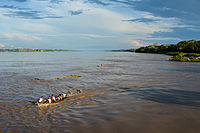
Photo from wikipedia
Water-use efficiency (WUE), defined as the ratio of net primary productivity (NPP) to evapotranspiration (ET), is an important indicator to represent the trade-off pattern between vegetation productivity and water consumption.… Click to show full abstract
Water-use efficiency (WUE), defined as the ratio of net primary productivity (NPP) to evapotranspiration (ET), is an important indicator to represent the trade-off pattern between vegetation productivity and water consumption. Its dynamics under climate change are important to ecohydrology and ecosystem management, especially in the drylands. In this study, we modified and used a late version of Boreal Ecosystem Productivity Simulator (BEPS), to quantify the WUE in the typical dryland ecosystems, Temperate Eurasian Steppe (TES). The Aridity Index (AI) was used to specify the terrestrial water availability condition. The regional results showed that during the period of 1999–2008, the WUE has a clear decreasing trend in the spatial distribution from arid to humid areas. The highest annual average WUE was in dry and semi-humid sub-region (DSH) with 0.88 gC mm-1 and the lowest was in arid sub-region (AR) with 0.22 gC mm-1. A two-stage pattern of WUE was found in TES. That is, WUE would enhance with lower aridity stress, but decline under the humid environment. Over 65% of the region exhibited increasing WUE. This enhancement, however, could not indicate that the grasslands were getting better because the NPP even slightly decreased. It was mainly attributed to the reduction of ET over 70% of the region, which is closely related to the rainfall decrease. The results also suggested a similar negative spatial correlation between the WUE and the mean annual precipitation (MAP) at the driest and the most humid ends. This regional pattern reflected the different roles of water in regulating the terrestrial ecosystems under different aridity levels. This study could facilitate the understanding of the interactions between terrestrial carbon and water cycles, and thus contribute to a sustainable management of nature resources in the dryland ecosystems.
Journal Title: PLoS ONE
Year Published: 2017
Link to full text (if available)
Share on Social Media: Sign Up to like & get
recommendations!